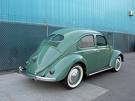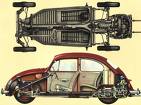VW Beetle

vw beetle accessories
The VW Beetle. Official name Volkswagen Type 1 is an economy car produced by the German motor company Volkswagen from 1938 until 2003. It used an air cooled rear engined rear wheel drive.
In the 1950s the VW Beetle was more comfortable and powerful than most European small cars, having been designed for sustained high speed on the Autobahn, and ultimately became the longest-running and most-produced car of a single design. It remained a top seller in america, even as rear-wheel drive conventional subcompacts were refined, and eventually replaced by front-wheel drive cars. Its success owed much to its extremely high build quality, and innovative and eye catching advertising. The Beetle car was the benchmark for both generations of American compact cars such as the Chevvy Corvair, and subcompact cars such as the Chevvy Vega and Ford Pinto. It was the German equivalent and counterpart to the Morris Minor, Renault 4CV, Citroen 2CV, Fiat 600, Saab 92, and Volvo PV444 post war European economy cars. The 1948 Citroen 2CV was the beginning of a switch to front wheel drive by European manufacturers in the 1960s and 1970s, Volkswagen were among the last to change with the Golf. The VW Beetle was 13ft long and the Mini was only 10ft, but they had similar interior space.
The car was originally known as Käfer, the German word for "beetle", from which the popular English nickname originates. It was not until August 1967 that the Volkswagen corporation itself began using the name Beetle as marketing material. In Britain, VW never used the name Beetle officially. It had only been known as either the "Type I" or as the 1100, 1200, 1300, 1500, or 1600 which had been the names under which the vehicle was marketed in Europe; the numbers denoted the vehicle's approximate engine size in cubic centimetres. In 1998, many years after the original model had been dropped from the lineup in most of the world (production continued in Mexico until discontinued, officially on 9 July 2003), VW introduced the "New Beetle" which was cosmetically similar to the original.

History of "The peoples car"
In 1933, Adolf Hitler gave the order to Ferdinand Porsche to develop a "Volks-Wagen". The concept may have been influenced by an earlier design of the same name, created by Josef Ganz, a Jewish engineer who had designed a "Volks-Wagen" in the 1920s. Meaning "people's car" in German, in which it is pronounced. Hitler wanted a basic vehicle capable of carrying 2 adults and 3 children at 100 km/h (62 mph). The "People's Car" would be available to citizens of the Third Reich through a savings scheme at 990 Reichsmark, about the price of a small motorbike (an average earnings around 32RM a week).
Erwin Komenda, Porsche's chief designer, was responsible for the design and style of the car. But production only became worthwhile when finance was backed by the Third Reich. War started before large-scale production of the VW Beetle began, and manufacturing shifted towards military vehicles. Production of civilian VW automobiles did not begin until post-war occupation.
Military VW Beetles and production to 1945.
Originally called the Porsche 60 by Ferdinand Porsche, it was officially named the KdF-Wagen when project was launched. The name refers to Kraft durch Freude ('Strength Through Joy'), the official leisure organization in the Third Reich. Later being known as the Type 1, Becoming more commonly known as the Beetle after the second world war.
Prototypes appeared from 1931; the first were produced by Zündapp in Nürnberg, the Porsche Type 12. The next prototype series (Porsche Type 32) were built in 1933 by NSU Motorenwerke AG (NSU), a motorcycle company. When Chrysler brought out its DeSoto Airflow coupe in 1934, design for the car was decided.
In Oct 1935 the first Type 60 was ready. In 1935 testing of the V3 started. The VW30 prototypes had more testing in 1937. All cars already had the distinctive round shape and the air-cooled, rear-mounted engine, except the Type 12, Zündapp preferred a 5-cylinder radial watercooled engine for this one.
The factory had only produced a handful of cars before start of the war in 1939. Consequently, the first volume-produced versions of car chassis were military vehicles, the Kübelwagen Type 82 (approx. 52,000 built) and the amphibious Schwimmwagen Type 166 (approx. 14,000 built).
The car was designed to be as simple as possible mechanically, so less to go wrong the aircooled 985 cc 25 horsepower (19 kW) motors proved especially effective in actions of the German Afrika Korps in the African desert heat. This was due to the built-in oil-cooler, and superior performance of the flat-4 engine set-up. The innovative suspension design used torsion bars instead of leaf or coil springs. The VW Beetle is more or less airtight and will float on water, It is hard to slam the door on one since the difference in air pressure pushes it back before closes.
The model village of Stadt des KdF-Wagens was created in Lower Saxony in 1938 to benefit of the workers at the factory.
A handful of VW Beetles were produced specifically for civilians, primarily for the Nazi elite, in the years 1940–1945, but production was small. Because of fuel shortages, a few wartime "Holzbrenner" VW Beetles were fueled by wood pyrolysis gas producers under the hood. In addition to the Kübelwagen, Schwimmwagen, and handful of others, the factory managed another wartime vehicle: the Kommandeurwagen; a Beetle body mounted on the Kübelwagen chassis.
669 Kommandeurwagens were produced until 1945, when all production was halted because of the damage to the factory by Allied air raids. Much of the equipment had already been moved to underground bunkers for protection, which meant production could resume quickly after the hostilities ended.

Tatra conflict
Much of the VW Beetle’s design was inspired by the Czech Tatra cars, Under chief engineer Hans Ledwinka. Tatra’s T97 and T77a models show striking similarities with the later Volkswagen.
Thirties Tatras used streamlined bodies with rear-mounted engines. The T97, which is held to be the closest Tatra model to Porsche’s Volkswagen, it had a four-cylinder horizontally-opposed flat four air-cooled engine. in smaller scale, the V570, a prototype for a smaller car, also shows a resemblance to the later German car.
But it wasn’t just Tatra’s aerodynamic styling that influenced Porsche. Tatra pioneered the use of air-cooling in road vehicle engines with the T77 in 1934. Air-cooling was demanding technologically, but desirable: there was no anti-freeze in the 1930s, so a vehicle could not be left parked for long in cold weather with coolant in the engine. Tatra’s wealthy customers could afford to pay for advanced technology, but Ferdinand Porsche was out on a limb in specifying air-cooling for his people’s car. In the end, it was subsidies from the Nazi government that paid for Porsche’s engineering and brought the convenience of air-cooling to a mass audience.
It is said that Ferdinand Porsche admitted ‘to have looked over Ledwinka’s shoulder’ while designing the VW Beetle. Tatra launched a lawsuit, but was stopped when Germany invaded Czechoslovakia. At the same time, Tatra was forced to stop building the T97. The matter was re-opened after WW2 and in 1961 VW paid Tatra 3,000,000 Deutsche Marks in compensation. These damages meant that VW had little money for the development of new models and the Beetle's production life was extended. Tatra stopped producing passenger cars in 1950, then resumed again in 1954 as a manufacturer of large luxury cars and limousines under various Communist governments in Czechoslovakia. Even the company’s last limousines were rear-engined and air cooled.
Tatra is now a truck manufacturer. All its engines are still air-cooled.






